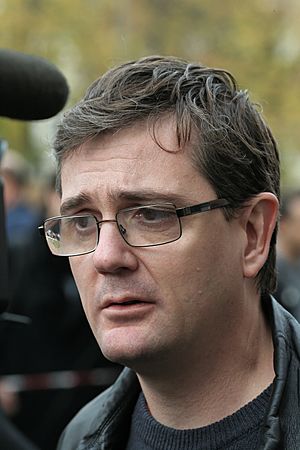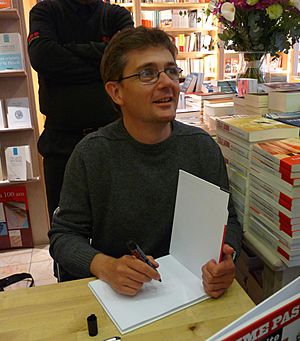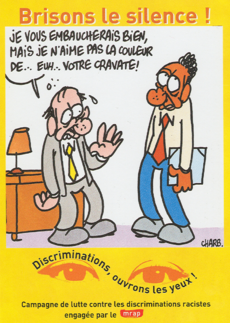Charb facts for kids
Quick facts for kids Stéphane Charbonnier |
|
|---|---|

Charb at the Charlie Hebdo office after a firebomb attack (2 November 2011)
|
|
| Born | Stéphane Jean-Abel Michel Charbonnier 21 August 1967 Conflans-Sainte-Honorine, France |
| Died | 7 January 2015 (aged 47) Paris 11e, France |
| Nationality | French |
| Area(s) | Cartoonist, journalist |
| Pseudonym(s) | Charb |
| Signature | |
 |
|
Stéphane Jean-Abel Michel Charbonnier (born August 21, 1967 – died January 7, 2015), known as Charb, was a French satirical cartoonist and journalist. He was known for his bold drawings and writings. Charb was sadly killed during the Charlie Hebdo attack on January 7, 2015.
He worked for several newspapers and magazines. He joined Charlie Hebdo in 1992 and became its director in 2009. Because Charlie Hebdo published cartoons that some found offensive, Charb received threats from extremist groups. He lived under police protection after the magazine was attacked in 2011. The police officer protecting Charb was also killed in the 2015 attack.
Early Life
Stéphane Charbonnier was born in Conflans-Sainte-Honorine, France, on August 21, 1967. He grew up in Pontoise. His parents were Michel and Denise Charbonnier. His father was a technician, and his mother was a secretary.
Charb's talent for drawing was noticed when he was in school. He published his first drawings at age fourteen. He continued drawing while studying at Lycée Camille Pissarro.
Career as a Cartoonist

In the late 1980s, Charb started working as a cartoonist. He drew for local newspapers like Les Nouvelles du Val-d'Oise. He also created cartoons for a cinema magazine.
Later, Charb worked as a freelance cartoonist for many well-known publications. These included L'Écho des savanes, Télérama, and L'Humanité. He joined Charlie Hebdo in 1992. He became the director of the magazine in 2009 and stayed in that role until his death.
Charb created a comic strip called Maurice et Patapon. It featured a dog named Maurice and a cat named Patapon. Maurice was described as a friendly, peace-loving dog. Patapon was a conservative, violent cat. Charb also drew a character called "Marcel Keuf, le flic" (Marcel Pig, the cop) for Fluide Glacial magazine. His column in Charlie Hebdo was titled "Charb n'aime pas les gens" ("Charb does not like people").
From 2007 to 2008, he was a cartoonist on a TV talk show called T'empêches tout le monde de dormir. Charb was a long-time supporter of the French Communist Party. He also drew cartoons for groups that fight against racism, like MRAP.
Threats and Attacks
On November 2, 2011, the Charlie Hebdo office was attacked with firebombs. This happened just before an issue was published that featured a cartoon of the Islamic prophet, Muhammad. After this attack, Charb and two of his co-workers received police protection.
In September 2012, a man was arrested for calling for violence against Charb on an extremist website.
In a 2012 interview, Charb said he was not afraid of threats. He stated, "I'd prefer to die on my feet than to live on my knees."
In 2013, Al-Qaeda put Charb on their "most-wanted list." This was after he edited an issue of Charlie Hebdo that made fun of radical groups. Charb was a sport shooter and tried to get permission to carry a gun for self-defense, but his request was not approved.
The week of the Charlie Hebdo attack, Charb had drawn a cartoon for the magazine. It joked about there being no terrorist attacks in France. The cartoon showed an armed fighter saying, "Wait!... we still have until the end of January to present our wishes." This was a dark joke about the French tradition of offering New Year's greetings until the end of January.
Beliefs
Charbonnier was an atheist, meaning he did not believe in a god. He was also a pacifist, meaning he believed in peaceful ways to solve problems.
Two days before he died, Charb finished an essay about Islamophobia. This essay was later published in English after his death. Its title is Open Letter: On Blasphemy, Islamophobia, and the True Enemies of Free Expression.
Death
Charb was killed on January 7, 2015. He died along with seven of his colleagues, two police officers, and two other people. This happened when gunmen attacked the Charlie Hebdo newspaper offices in Paris. One of the police officers killed, Franck Brinsolaro, was Charb's bodyguard.
His funeral was held in Pontoise, France. Many people attended, including other cartoonists, politicians, and government ministers.
See also
 In Spanish: Charb para niños
In Spanish: Charb para niños
- List of journalists killed in Europe


